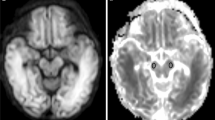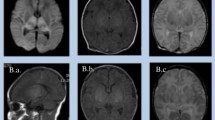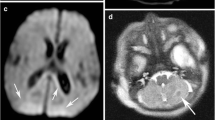Abstract
Background
Pseudonormalization of diffusion-weighted magnetic resonance imaging (MRI) can lead to underestimation of brain injury in newborns with hypoxic–ischemic encephalopathy (HIE), posing a significant problem. We have noticed that some neonates show pseudonormalization negativity on diffusion-weighted imaging.
Objective
To compare pseudonormalization negativity with clinical outcomes.
Materials and methods
Seventeen term neonates with moderate or severe HIE underwent therapeutic hypothermia. They were examined by MRI twice at mean ages of 3 days and 10 days. We evaluated the presence of restricted diffusion, and also the presence or absence of pseudonormalization, by diffusion-weighted imaging at the time of the second MRI, and correlated the results with clinical outcome.
Results
DWI demonstrated no abnormality in seven neonates. Among the 10 neonates with abnormal diffusion-weighted imaging findings, 2 were positive for pseudonormalization and 8 were negative. Among neonates with normal diffusion-weighted imaging findings and with positivity for pseudonormalization, none had major disability. Among the eight neonates with pseudonormalization negativity, all but one, who was lost to follow-up, had major disability.
Conclusion
Abnormal diffusion-weighted imaging with pseudonormalization negativity might be predictive of severe brain injury and major disability. The second-week MRI is important for the judgment of pseudonormalization.



Similar content being viewed by others
References
Shankaran S, Laptook AR, Ehrenkranz RA et al (2005) Whole-body hypothermia for neonates with hypoxic–ischemic encephalopathy. N Engl J Med 353:1574–1584
Gluckman PD, Wyatt JS, Azzopardi D et al (2005) Selective head cooling with mild systemic hypothermia after neonatal encephalopathy: multicentre randomized trial. Lancet 365:663–670
Azzopardi DV, Strohm B, Edwards AD et al (2009) Moderate hypothermia to treat perinatal asphyxia encephalopathy. N Engl J Med 361:1349–1358
Edwards AD, Brocklehurst P, Gunn AJ et al (2010) Neurological outcomes at 18 months of age after moderate hypothermia for perinatal hypoxic ischaemic encephalopathy: synthesis and meta-analysis of trial data. BMJ 340:c363
Jacobs SE, Berg M, Hunt R et al (2013) Cooling for newborns with hypoxic ischaemic encephalopathy. Cochrane Database Syst Rev 1:CD003311
Azzopardi D, Strohm B, Marlow N et al (2014) Effects of hypothermia for perinatal asphyxia on childhood outcomes. N Engl J Med 371:140–149
Boichot C, Walker PM, Durand C et al (2006) Term neonate prognoses after perinatal asphyxia: contributions of MR imaging, MR spectroscopy, relaxation times, and apparent diffusion coefficients. Radiology 239:839–848
Thayyil S, Chandrasekaran M, Taylor A et al (2010) Cerebral magnetic resonance biomarkers in neonatal encephalopathy: a meta-analysis. Pediatrics 125:e382–e395
Rutherford M, Counsell S, Allsop J et al (2004) Diffusion-weighted magnetic resonance imaging in term perinatal brain injury: a comparison with site of lesion and time from birth. Pediatrics 114:1004–1014
L’Abee C, de Vries LS, van der Grond J et al (2005) Early diffusion-weighted MRI and 1 H-magnetic resonance spectroscopy in asphyxiated full-term neonates. Biol Neonate 88:306–312
McKinstry RC, Miller JH, Snyder AZ et al (2002) A prospective longitudinal diffusion tensor imaging study of brain injury in newborns. Neurology 59:824–833
Winter JD, Lee DS, Hung RM et al (2007) Apparent diffusion coefficient pseudonormalization time in neonatal hypoxic-ischemic encephalopathy. Pediatr Neurol 37:255–262
Sarnat HB, Sarnat MS (1976) Neonatal encephalopathy following fetal distress: a clinical and electroencephalographic study. Arch Neurol 33:696–705
Vermeulen RJ, Fetter WPF, Hendrix L et al (2003) Diffusion-weighted MRI in severe neonatal hypoxic ischaemia: the white cerebrum. Neuropediatrics 34:72–76
van Rooij LG, Toet MC, van Huffelen AC et al (2010) Effect of treatment of subclinical neonatal seizures detected with aEEG: randomized, controlled trial. Pediatrics 125:e358–e366
Palisano R, Rosenbaum P, Walter S et al (1997) Development and reliability of a system to classify gross motor function in children with cerebral palsy. Dev Med Child Neurol 39:214–223
Barkovich AJ, Miller SP, Bartha A et al (2006) MR imaging, MR spectroscopy and diffusion tensor imaging of sequential studies in neonates with encephalopathy. AJNR Am J Neuroradiol 27:533–547
Bednarek N, Mathur A, Inder T et al (2012) Impact of therapeutic hypothermia on MRI diffusion changes in neonatal encephalopathy. Neurology 78:1420–1427
Mazumdar A, Mukherjee P, Miller JH et al (2003) Diffusion-weighted imaging of acute corticospinal tract injury preceding Wallerian degeneration in the maturing human brain. AJNR Am J Neuroradiol 24:1057–1066
Groenendaal F, Benders MJ, De Vries LS (2006) Pre-Wallerian degeneration in the neonatal brain following perinatal cerebral hypoxia–ischemia demonstrated with MRI. Semin Perinatol 30:146–150
Kasdorf E, Grunebaum A, Perlman JM (2015) Subacute hypoxic-ischemia and timing of injury in treatment with therapeutic hypothermia. Pediatr Neurol 53:417–421
Author information
Authors and Affiliations
Corresponding author
Ethics declarations
Conflicts of interest
None
Rights and permissions
About this article
Cite this article
Hayakawa, K., Koshino, S., Tanda, K. et al. Diffusion pseudonormalization and clinical outcome in term neonates with hypoxic–ischemic encephalopathy. Pediatr Radiol 48, 865–874 (2018). https://doi.org/10.1007/s00247-018-4094-z
Received:
Revised:
Accepted:
Published:
Issue Date:
DOI: https://doi.org/10.1007/s00247-018-4094-z




